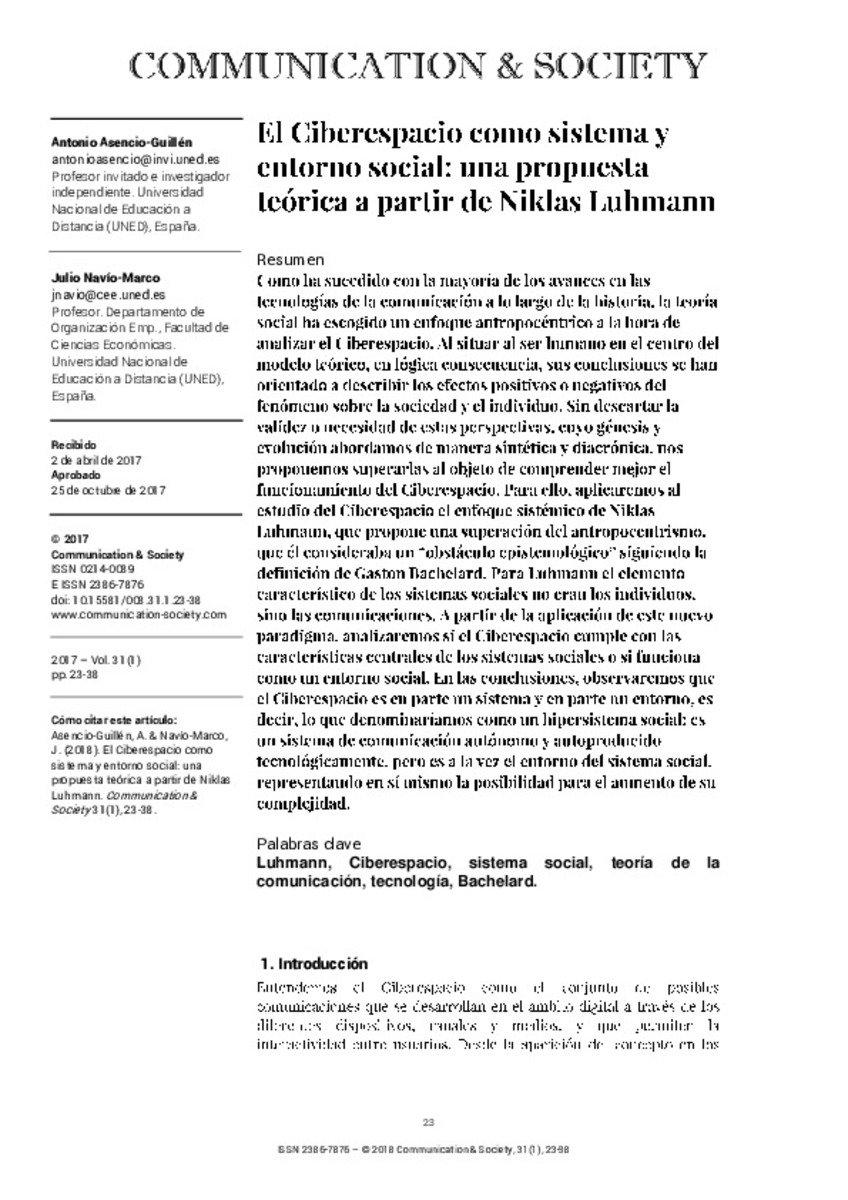Full metadata record
| DC Field | Value | Language |
|---|---|---|
| dc.creator | Asencio-Guillén, A. (Antonio) | - |
| dc.date.accessioned | 2018-10-17T10:46:39Z | - |
| dc.date.available | 2018-10-17T10:46:39Z | - |
| dc.date.issued | 2018 | - |
| dc.identifier.citation | Asencio-Guillén, A. (Antonio). "El Ciberespacio como sistema y entorno social: una propuesta teórica a partir de Niklas Luhmann". Communication & Society. 31 (1), 2018, 23 - 38 | es |
| dc.identifier.issn | 2386-7876 | - |
| dc.identifier.uri | https://hdl.handle.net/10171/54617 | - |
| dc.description.abstract | Como ha sucedido con la mayoría de los avances en las tecnologías de la comunicación a lo largo de la historia, la teoría social ha escogido un enfoque antropocéntrico a la hora de analizar el Ciberespacio. Al situar al ser humano en el centro del modelo teórico, en lógica consecuencia, sus conclusiones se han orientado a describir los efectos positivos o negativos del fenómeno sobre la sociedad y el individuo. Sin descartar la validez o necesidad de estas perspectivas, cuyo génesis y evolución abordamos de manera sintética y diacrónica, nos proponemos superarlas al objeto de comprender mejor el funcionamiento del Ciberespacio. Para ello, aplicaremos al estudio del Ciberespacio el enfoque sistémico de Niklas Luhmann, que propone una superación del antropocentrismo, que él consideraba un “obstáculo epistemológico” siguiendo la definición de Gaston Bachelard. Para Luhmann el elemento característico de los sistemas sociales no eran los individuos, sino las comunicaciones. A partir de la aplicación de este nuevo paradigma, analizaremos si el Ciberespacio cumple con las características centrales de los sistemas sociales o si funciona como un entorno social. En las conclusiones, observaremos que el Ciberespacio es en parte un sistema y en parte un entorno, es decir, lo que denominaríamos como un hipersistema social: es un sistema de comunicación autónomo y autoproducido tecnológicamente, pero es a la vez el entorno del sistema social, representando en sí mismo la posibilidad para el aumento de su complejidad. | es_ES |
| dc.description.abstract | As has been the case with most of the advances in communication technologies throughout history, social theory has chosen an anthropocentric approach to the analysis of cyberspace. The human being is placed at the centre of the theoretical model, and as a logical consequence, findings have been oriented towards describing the positive or negative effects of the phenomenon on society and the individual. Without discarding the validity or necessity of these perspectives, whose genesis and evolution we address synthetically and diachronically, we propose to improve on them in order to better understand the functioning of cyberspace. To do this, we will apply to the study of cyberspace the systemic approach of Niklas Luhmann, who proposes going beyond anthropocentrism, which he considered to be an "epistemological obstacle”, to use Gaston Bachelard’s definition. For Luhmann the characteristic element of social systems was not individuals, but communications. By applying this new paradigm, we will consider whether cyberspace complies with the central features of social systems or if whether it functions like a social environment. In the conclusions, we will observe that cyberspace is in part a system and in part an environment; in other words, what we would call a social hypersystem. It is a communication system that is autonomous and self-produced technologically, but it is, at the same time, the environment of the social system, representing in itself the possibility of increasing its complexity. | es_ES |
| dc.language.iso | spa | es_ES |
| dc.publisher | Servicio de Publicaciones de la Universidad de Navarra | es_ES |
| dc.rights | info:eu-repo/semantics/openAccess | es_ES |
| dc.subject | Luhmann | es_ES |
| dc.subject | Ciberespacio | es_ES |
| dc.subject | sistema social | es_ES |
| dc.subject | teoría de la comunicación | es_ES |
| dc.subject | tecnología | es_ES |
| dc.subject | Bachelard | es_ES |
| dc.title | El Ciberespacio como sistema y entorno social: una propuesta teórica a partir de Niklas Luhmann | es_ES |
| dc.title.alternative | Cyberspace as a system and a social environment: a theoretical proposal based on Niklas Luhmann | es_ES |
| dc.type | info:eu-repo/semantics/article | es_ES |
| dc.publisher.place | Pamplona | es_ES |
| dc.identifier.doi | 10.15581/003.31.35725 | es_ES |
| dadun.citation.endingPage | 38 | es_ES |
| dadun.citation.number | 1 | es_ES |
| dadun.citation.publicationName | Communication & Society | es_ES |
| dadun.citation.startingPage | 23 | es_ES |
| dadun.citation.volume | 31 | es_ES |
Files in This Item:
Statistics and impact
Items in Dadun are protected by copyright, with all rights reserved, unless otherwise indicated.






